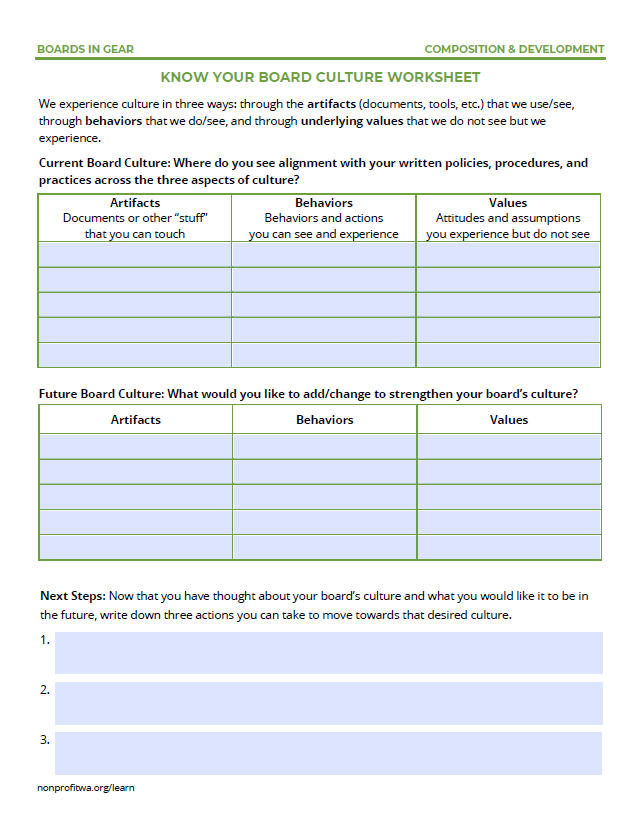Regardless of the size of your organization, every volunteer, worker, donor, and funder that engages with your nonprofit will experience your board culture in some way. Culture is the way a group of people comes together. Your nonprofit’s board culture stems from your procedures, policies, and practices. Your board culture matters in your organization’s overall ability to achieve its mission, create meaningful engagement, and develop lasting relationships.
Aspects of culture are both visible and invisible, and culture is often compared to an iceberg because 90% of an iceberg is unseen below the waterline. Your organization should aspire to create a board culture that provides a stable foundation for the nonprofit, supports your mission and values, and welcomes board members with diverse experiences, abilities, and skills. You can explore the visible and invisible parts of your culture to better understand where the board is now and what changes may be needed. Strong board culture is vital to every nonprofit.
In an organization, culture includes the systems of knowledge shared by individuals engaged with the board – the values, beliefs, attitudes, and roles individuals take within the nonprofit. Culture, in general, shows up in three ways: artifacts, behaviors, and underlying values. We break this down with the following examples related to boards.
Topics covered:
Artifacts
Artifacts are the “stuff” of the organization. This includes things that someone could see by moving around your workplace or interacting with your board. Some artifacts are less visible and may be known by specific board or staff members. Artifacts can be tools, documents, procedures, and more. Together, your artifacts represent visible or accessible indicators of your board and organization’s policies and procedures. Artifacts may include:
- Incorporation documents
- Bylaws
- Whistleblower Policy
- Conflict of Interest Policy
- Board member reimbursement policy
- Board orientation packet
Behaviors
Behaviors are what you can observe or witness when people interact with the board’s systems and implement procedures that are in place. Behaviors may include:
- Conversations and casual comments
- Participation and questions asked in meetings
- How people interact across the organization, like staff and board
- How individuals and committees respond when faced with a challenge or conflict
Underlying Values
Underlying values are invisible elements that nevertheless shape a culture. A nonprofit may say having a board membership reflective of the community served by the organization is important, a priority, and crucial to advancing the work. The underlying beliefs must exist so that everyone on the board matches their words with aligned actions. The invisible elements may include:
- Values related to what matters within a board and organization
- Assumptions that common understandings are shared
- Attitudes about recordkeeping
- Attitudes about acceptable oversight behaviors
- Unspoken rules
- Beliefs and habitats
Assess Your Culture

The first step in strengthening your board’s culture is to assess your current culture. Use the following “Know Your Board Culture” worksheet to note how you would describe your culture across the three aspects (artifacts, behaviors, and underlying values). Then describe how you want your board culture to be in the future. Remember, you can change the culture.

Assess Your Board Culture Worksheet
Use this worksheet to think about the artifacts, behaviors, and underlying values that make up your board's culture.
Download